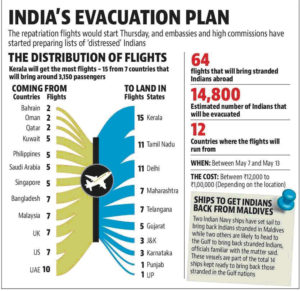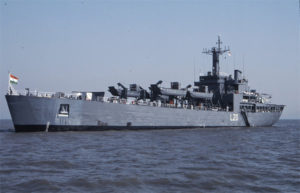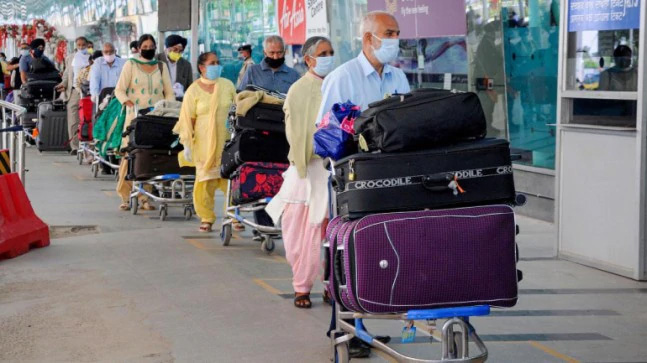Sixty Four Flights Will Bring Home 15,000 Indians In A Week
05 May, 2020
New Delhi : India has launched a concerted repatriation programme, by sea and air, to bring back stranded citizens stuck in various parts of the world, but with a strict set of preconditions to prevent the spread of the coronavirus disease (Covid-19), at a time when nations are trying to strike a balance between humanitarian considerations, responsibility towards citizens, and health concerns, in the face of a deadly pathogen.
In the first week of a massive air operation, which will start on Thursday, 64 flights will bring 15,000 Indian citizens home from 12 countries. All those who travel back will have to pay for their tickets, undergo strict screening processes, download the Aarogya Setu app, and go into institutional quarantine after landing.
The Indian Navy, on Tuesday, already kicked off one leg of the complex evacuation exercise by dispatching two amphibious warships to Male to evacuate Indians stranded in the Maldives, a spokesperson said. Two more warships may soon be dispatched to the Gulf , an officer familiar with the matter added.
The overall plan involves key ministries of the government. Minister for state (independent charge) civil aviation Hardeep Puri outlined the air operation; the ministry of home affairs came out with a set of standard operating procedures that all passengers who avail the facility will have to abide by; and the ministry of external affairs coordinated with foreign governments as well as ministries and state governments within.

The government has not termed it an “evacuation” but an exercise for the movement of Indian citizens stranded abroad.
On March 22, India suspended all international flights. For 45 days, there has been no international passenger movement to and from India — except international cargo flights and special flights arranged by foreign embassies, permitted by India. But this has also meant that hundreds of thousands of Indians — abroad for educational, professional, tourism or economic purposes, among other reasons — remain stuck. They have been demanding arrangements to get back home, but apprehensive that they may be carriers of the disease, the government had not done it so far.
The first phase of bringing back Indian citizens by air runs from May 7 to May 13. The 12 countries involved in it will be United Arab Emirates, Saudi Arabia, Qatar, Bahrain, Kuwait, Oman, Bangladesh, Philippines, Singapore, Malaysia, United Kingdom and United States, according to the flight plan for return of Indian nationals stranded abroad reviewed by HT.
At a time when there has been a controversy over the train fares for migrant workers, the government clarified that international passengers will be charged for the journey. Some of the fares (one way) from cities in the Gulf countries such as Abu Dhabi, Dubai and Doha to Kochi, Kerala range from ₹15,000 to ₹16,000. Rescue flights from London to India will cost ₹50,000 while flights from the United States to India have been priced at ₹100,000. “If there was no charge, people wanting to come back would be much higher,” Puri said. He also emphasised that these are commercial services being carried out under “special circumstances”, and that the exchequer does not have the space to pay for repatriation of all stranded Indians abroad. Puri said that only Air India flights will be deployed in this phase — 40 from the national carrier and 24 from its subsidiary Air India Express. “We will consider involving private airlines as well going forward,” he added.
According to Puri, the requests received by Indian embassies of Indians wishing to return are increasing by the day, and have now gone beyond the initial estimate of 200,000.
“The numbers are quite significant…More than 300,000 people have registered in West Asia alone but we will only bring back those registered as compelling cases. The missions will determine the compelling cases,” said a person familiar with the decision. He added that if someone was living in another country and was comfortable, this was not the time to plan one’s return.
The MHA SOP said that priority will be given to “asymptomatic” migrant labourers/workers abroad who have been laid off, short term visa holders faced with expiry (of visas), persons with medical emergency, pregnant women, the elderly, students, and those required to return to India due to the death of a family member.
The SOP also adds that these flights will also be used to transport people in the other direction, from India to abroad. Foreign citizens of the destination countries, those who hold a visa of the concerned country of at least a year, green card holders, Overseas Citizen of India (OCI) card holders and in case of medical emergency or death in the family, Indian nationals with a valid six month visa can travel to the country. But this has a caveat; they will have to fulfil any conditions imposed by the destination country they intend to travel. They will travel on the non-scheduled commercial flights being arranged to bring back Indian citizens. And they too will have to bear the cost of travel and follow all health protocols.

INS Jalashwa
The Indian Navy, on Tuesday morning, dispatched two amphibious warships to Male to evacuate Indians stranded in the Maldives. Indian warships INS Jalashwa and INS Magar are currently on their way to the port of Male and are expected to bring back 1,000 people, a spokesperson said. Two more warships may soon be dispatched to West Asia for evacuating Indians, while a dozen more are on standby for undertaking any mission assigned to them, a person familiar with the planning in the navy said. Indian Air Force transport planes are also on standby for the evacuation but the IAF hasn’t been given any orders yet.

INS Magar

C 17
External affairs minister S Jaishankar and foreign secretary Harsh Shringla are overseeing the process of coordinating with foreign governments, Indian missions and state governments. Jaishankar has been holding meetings with other ministries and had a video conference with heads of missions in some of the countries from which Indians are returning, including the UAE, Singapore, the Maldives and the US. At least 20 senior officials of the external affairs ministry have been selected to liaise with the states to which the Indian nationals will return. The foreign secretary will have a video conference with chief secretaries of several states on Wednesday for coordination.
The external affairs ministry will upload all information on the people returning to the country on an online digital platform that will be accessible to other ministries and state governments. The data on those who lost their jobs will help state governments rehabilitate these workers by including them in national or state government employment programmes or in private sector jobs, a second person aware of the matter said. This person also insisted that the massive programme was not an evacuation because it is not a government-sponsored exercise. “What we are doing is facilitating the return of our nationals back to the country.” But all the planning has been accompanied with a recognition that India needs to be careful that the returnees do not end up spreading the disease, and possibly squandering away the benefits of the lockdown so far.
According to the SOPs issued by the MHA, passengers will have to undergo screening process before taking off, and be allowed only if they are asymptomatic. They will also have to give an undertaking that they are taking the journey at their own risk apart providing personal and health data. In the aircraft, they are expected to abide by health protocols — by wearing masks and maintaining hygiene.
Upon their arrival, they will once again undergo the screening process. Those found “symptomatic” after reaching India will be immediately taken to a medical facility, while others will have to undergo mandatory institutional quarantine of 14 days, for which they will have to pay. All passengers will have to download the Aarogya Setu app.
The decision came as a major source of relief for many Indians abroad, as well as to their families back home. Swati Arora, a Gurugram-based homemaker, said her husband has been stranded in Kuala Lumpur since February, while she is also due to deliver a child by the end of May and has been requesting authorities for over a month for a way out. “My husband had gone for a work trip and his business visa, which was issued for 28 days, had expired. We have been constantly requesting the MEA and the embassy. We have also been tweeting about it tirelessly. I want my husband to be back in time for the delivery. The embassy has contacted him and a group of others stranded there informing that they will have to pay for their tickets and also quarantine facilities,” she added.
Courtesy: HT

